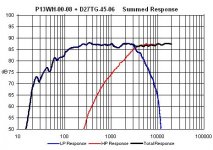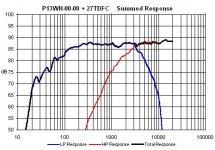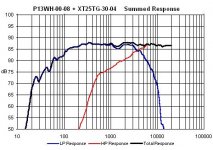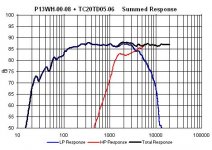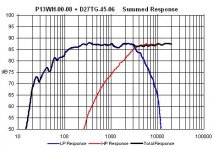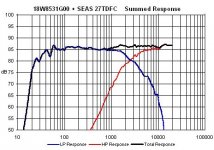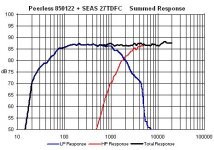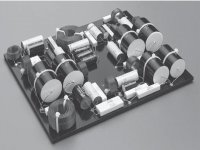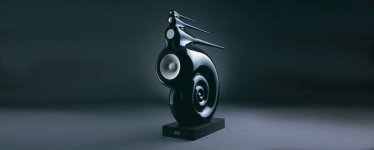I'm afraid I discarded the Vifa poly woofer/Seas aluminum tweeter a while back without noting what models they were, but they were made around 1991. I believe the crossover was 2nd order at around 2200hz. My first speaker project was converting that simple 2-way to active digital crossover and swapping out the tweeter.
Right, you have to choose drivers that will work. My drivers are a hodge podge of old and new drivers I've collected over 10 years.
SS 6600 and RS52 aren't aided by natural roll off anywhere near the crossover points I'm using.
Right, you have to choose drivers that will work. My drivers are a hodge podge of old and new drivers I've collected over 10 years.
SS 6600 and RS52 aren't aided by natural roll off anywhere near the crossover points I'm using.
Jay_WJ said:
So, you'd want to use the TB driver for a BW1 design?
A true 1st order design is rare unless someone intends to implement it to showcase one.
Drivers like that , I'm not at all sure of. I like to try to combine the x-o roll-off with at least a bit of driver roll-off if I can.. and that driver doesn't really have a roll-off to speak of at the top end.
I would have to import it anyway, so it really isn't an issue
I think we need to get on the same wavelength on crossover orders as it is causing confusion as well as friction.
Even though it is the acoustic slope or order we are after in the end, I think it might be worthwhile discussing using the electrical crossover slopes as that's what everyone can see in the physical crossover. To see the actual acoustic slope you have to measure or model which you can't do when reading a post. We know that the 1st order electrical will give us BW2 or LR2 or whatever acoustic slopes, but not always as some tweeters shelve which in turn give less than 6dB slopes. What has not been mentioned is some of the benefits of 1st order electrical such as being constant voltage, phase etc (there is a good article on 1st order series by John Kreskovsky and yes, he talks about 1st order electrical) but requires certain criteria to be met to pull it off such as driver offsets.... alignment.
I've heard Andy's speakers and in fact on Friday heard the Rocket which was a real blast (no pun intended). There was no hint of the tweeter being distressed at any point and this speaker uses 1st order electrical filters with the SEAS 27TDFC. Common sense as well as Vance Dickason tells us to cross over the tweeter 1.5 - 2 octaves above the Fs as a minimum and Andy has these at over 2 octaves above the Fs.
There are 2 things that have stuck in the brain since I started designing speakers. The first is to use the minimum crossover that will get the job done and the second is to choose your drivers wisely to suit the application and filters.
My crossover of choice these days is the AR series crossovers which do give around LR2 acoustic slopes.
I'll show you some acoustic slopes on various tweeters using some example speakers that have been built.
Even though it is the acoustic slope or order we are after in the end, I think it might be worthwhile discussing using the electrical crossover slopes as that's what everyone can see in the physical crossover. To see the actual acoustic slope you have to measure or model which you can't do when reading a post. We know that the 1st order electrical will give us BW2 or LR2 or whatever acoustic slopes, but not always as some tweeters shelve which in turn give less than 6dB slopes. What has not been mentioned is some of the benefits of 1st order electrical such as being constant voltage, phase etc (there is a good article on 1st order series by John Kreskovsky and yes, he talks about 1st order electrical) but requires certain criteria to be met to pull it off such as driver offsets.... alignment.
I've heard Andy's speakers and in fact on Friday heard the Rocket which was a real blast (no pun intended). There was no hint of the tweeter being distressed at any point and this speaker uses 1st order electrical filters with the SEAS 27TDFC. Common sense as well as Vance Dickason tells us to cross over the tweeter 1.5 - 2 octaves above the Fs as a minimum and Andy has these at over 2 octaves above the Fs.
There are 2 things that have stuck in the brain since I started designing speakers. The first is to use the minimum crossover that will get the job done and the second is to choose your drivers wisely to suit the application and filters.
My crossover of choice these days is the AR series crossovers which do give around LR2 acoustic slopes.
I'll show you some acoustic slopes on various tweeters using some example speakers that have been built.
This is a speaker that is from the diyAudio reference speaker thread.
http://www.diyaudio.com/forums/showthread.php?postid=1005310#post1005310
This is the response of a Vifa D27TG-45-06 (also D27TG-35-06) using a 1st order electrical series filter. At Fs, the tweeter is down around 20dB which is a good place to be.
http://www.diyaudio.com/forums/showthread.php?postid=1005310#post1005310
This is the response of a Vifa D27TG-45-06 (also D27TG-35-06) using a 1st order electrical series filter. At Fs, the tweeter is down around 20dB which is a good place to be.
Attachments
Now swap the tweeter for the SEAS 27TDFC (one of my favourites BTW).
Close enough to being 25dB down at Fs.... pretty cool. With the 1st order filter plus the natural driver roll off gives us great suppression at Fs.
Zaph used it in a speaker crossing over at 1700Hz (2nd order electrical) and made this comment:
Large MTM's need a tweeter with high power handling, low Fs and low distortion in the range of 1500 Hz and up. Not a whole lot of tweeters can claim that, particularly in the $30 range, but the Seas 27TDFC is up to the challenge.
It's a great tweeter... I think I said that before.
Close enough to being 25dB down at Fs.... pretty cool. With the 1st order filter plus the natural driver roll off gives us great suppression at Fs.
Zaph used it in a speaker crossing over at 1700Hz (2nd order electrical) and made this comment:
Large MTM's need a tweeter with high power handling, low Fs and low distortion in the range of 1500 Hz and up. Not a whole lot of tweeters can claim that, particularly in the $30 range, but the Seas 27TDFC is up to the challenge.
It's a great tweeter... I think I said that before.
Attachments
Here's a 27TDFC with a 18W8531 designed for lazyfly who is a member of this forum. Nice wide overlap which some say sounds nicer, large dip in the reverse null indicating a good phase relationship using the amp friendly AR series filter (1st order tweeter, 2nd order woofer electrical).
He reported the tweeter has no problems at all and would be a waste of money with a more expensive tweeter.
He reported the tweeter has no problems at all and would be a waste of money with a more expensive tweeter.
Attachments
.... and really pushing it, the 27TDFC at about 1700Hz with a 2nd order electrical filter. Doesn't sound as good as the 1st order electrical on the tweeter when the woofer was crossed over higher.
There ends the rant and it all comes down to tweeter choice to do the job / application as they are not created equal for sure. You want lower orders, you just have to choose well.
On a side note and Andy can confirm this, that I did end up making a great sounding speaker sound worse by chasing response and phase by modeling and believing in software. I had to step back, go back some paces before I could move ahead. My gut feelings and listening impressions were more fruitful. The software is a good guide, starting point, checking for sure but does not tell the full story.
Happy designing and building to all.
There ends the rant and it all comes down to tweeter choice to do the job / application as they are not created equal for sure. You want lower orders, you just have to choose well.
On a side note and Andy can confirm this, that I did end up making a great sounding speaker sound worse by chasing response and phase by modeling and believing in software. I had to step back, go back some paces before I could move ahead. My gut feelings and listening impressions were more fruitful. The software is a good guide, starting point, checking for sure but does not tell the full story.
Happy designing and building to all.
Attachments
Also, it should be pointed out that even Siegfried himself refers to LR2 on his web site in terms of the electrical effect, in both the passive and active x-o sections. All his graphs and calculations are done in electrical terms.
The LR2 filter is 12dB, the acoustic reponse cannot be determined without knowing the drivers.
Same applies to the 1st order series x-o. At zeta=1, they are 6dB electrical. And that is how they should be referred to, 1st order filters.
When talking about digital x-o, everyone talks about the electrical effect.. ie the settings on the x-o.
The LR2 filter is 12dB, the acoustic reponse cannot be determined without knowing the drivers.
Same applies to the 1st order series x-o. At zeta=1, they are 6dB electrical. And that is how they should be referred to, 1st order filters.
When talking about digital x-o, everyone talks about the electrical effect.. ie the settings on the x-o.
Attached photo is the 1st order crossover from a Thiel 3-way speaker which compensates for speaker physical acoustic roll-off and break-up effects.
Thiel has moved to a coaxial mid-tweeter to solve some 1st order large frequency overlap problems. B&W Speakers white paper mentions that using the same cone material on all drivers is important for 1st order speakers.
If you have the opportunity, listen to speakers like Linkwitz Orion which put most of the vocal frequencies on one speaker and accepts the issues of steep xovers at the top and bottom to keep a coherent midrange. This sounds best to my ears. I use 12th order at 80Hz and 4th order at 3000 Hz
Thiel has moved to a coaxial mid-tweeter to solve some 1st order large frequency overlap problems. B&W Speakers white paper mentions that using the same cone material on all drivers is important for 1st order speakers.
If you have the opportunity, listen to speakers like Linkwitz Orion which put most of the vocal frequencies on one speaker and accepts the issues of steep xovers at the top and bottom to keep a coherent midrange. This sounds best to my ears. I use 12th order at 80Hz and 4th order at 3000 Hz
Attachments
As Jay says. the only reason for creating a 1st order acoustic cross-over is as a curiosity.
And you can see just how complicated (and pointless?) it is !!!
ps: and here is a thought....
Passive components can only SUBTRACT from the real signal, they CANNOT add. Therefore, the more components you add to a cross-over the more you subtract from the real signal !!!
And you can see just how complicated (and pointless?) it is !!!
ps: and here is a thought....
Passive components can only SUBTRACT from the real signal, they CANNOT add. Therefore, the more components you add to a cross-over the more you subtract from the real signal !!!
LineSource said:Attached photo is the 1st order crossover from a Thiel 3-way speaker which compensates for speaker physical acoustic roll-off and break-up effects.
Very interesting xo and it's an acoustic 1st order? Those parts would keep me going for several speakers.
Thiel has moved to a coaxial mid-tweeter to solve some 1st order large frequency overlap problems. B&W Speakers white paper mentions that using the same cone material on all drivers is important for 1st order speakers.
B&W don't use the same driver material on their 1st order xo as it's tweeter to mid only for the 800 series. I think you find a lot who do 1st order xo's (electrical) do use the same or similar materials on their mids and woofer as they need well behaved drivers such as those with polypropylene cones so no correction is required.
If you have the opportunity, listen to speakers like Linkwitz Orion which put most of the vocal frequencies on one speaker and accepts the issues of steep xovers at the top and bottom to keep a coherent midrange. This sounds best to my ears. I use 12th order at 80Hz and 4th order at 3000 Hz
Now you are starting to talk full range with a woofer and tweeter to fill in the the lacking parts of the frequency response. 12th order.... whoa...
An interesting question is what is a good range for a mid woofer to cover the important midrange? From the numbers I have I would say 160Hz to 2560Hz based on the 3 + 4 + 3 octave split for bass, mid, treble. Any other opinions on this?
Slightly ot,
The tweeter in B&W's flagship 800 series , Must have very high power handling. Imagine that it has 1st order filter at 4khz and could keep up ( I speculate and believe) with the SPL of the two 10" woofers.
Can you calculate , If the TDFC , HDS tweeter and other higher end tweeters, Could keep up with the sound pressure level of two 10" woofers in a 3 way TMWW speaker design, Using only a single capacitor tuned at 4Khz , like the B&W does?
The tweeter in B&W's flagship 800 series , Must have very high power handling. Imagine that it has 1st order filter at 4khz and could keep up ( I speculate and believe) with the SPL of the two 10" woofers.
Can you calculate , If the TDFC , HDS tweeter and other higher end tweeters, Could keep up with the sound pressure level of two 10" woofers in a 3 way TMWW speaker design, Using only a single capacitor tuned at 4Khz , like the B&W does?
marchel
I can't see why not unless stupidly high SPL's are required.
The SPL of the B&W 800D is 90dB with those 2 woofers pumping.... remember baffle step and passive filter losses (I don't know what the bass drivers use, active or passive). I'm sure the 27TDFC could keep up within sensible levels.
Using Andy's power sharing XLS file, for a 400W amp, the bass would use 196W, tweeter 56W which is within the 90W continuous on the datasheet. No allowances have been made in those calcs for impedance variations of the drivers.
Andy's Rocket uses 2 drivers in parallel for the mids and even though they are padded slightly, the SPL would only be 2-3dB less than this and the 27TDFC has no problems keeping up.
I'm not sure but I bet the woofer would give up first by running out of xmax... thud... clunk.... @$&%.
I can't see why not unless stupidly high SPL's are required.
The SPL of the B&W 800D is 90dB with those 2 woofers pumping.... remember baffle step and passive filter losses (I don't know what the bass drivers use, active or passive). I'm sure the 27TDFC could keep up within sensible levels.
Using Andy's power sharing XLS file, for a 400W amp, the bass would use 196W, tweeter 56W which is within the 90W continuous on the datasheet. No allowances have been made in those calcs for impedance variations of the drivers.
Andy's Rocket uses 2 drivers in parallel for the mids and even though they are padded slightly, the SPL would only be 2-3dB less than this and the 27TDFC has no problems keeping up.
I'm not sure but I bet the woofer would give up first by running out of xmax... thud... clunk.... @$&%.
I suppose that B&W is advertising a 6db filter...has anyone ever seen the actual slopes...maybe they are only referring to a 6db electrical filter
I think it would help a lot if we in the future would refer to the XO only as the physical components, meaning that an XO can only be electrical
When referring to the acoustical result after the drivers we should refer to it only as driver slopes
Just my 2cents
I think it would help a lot if we in the future would refer to the XO only as the physical components, meaning that an XO can only be electrical
When referring to the acoustical result after the drivers we should refer to it only as driver slopes
Just my 2cents
HI rabbitz,
For me , Reaching the limits of two 10" woofers per channel would be rediculously loud.
But having no experience with that kind of project, Made me wonder if ordinary tweeters would fry at max level with that kind of filter.
Hi tinitus,
B&W does'nt mention that the slope is acoustical, But rather describe the xo as 6db / octave with only a capacitor between the tweeter and the signal.
BUt as you said , Has anyone seen the actual slope? As it is unlikely that the owners of 800d would open up their speaker and measure it, There is no separate terminal for the tweeter in that speaker, So even the pro reviewers will unlikely see the actual slope.
For me , Reaching the limits of two 10" woofers per channel would be rediculously loud.
But having no experience with that kind of project, Made me wonder if ordinary tweeters would fry at max level with that kind of filter.
Hi tinitus,
B&W does'nt mention that the slope is acoustical, But rather describe the xo as 6db / octave with only a capacitor between the tweeter and the signal.
BUt as you said , Has anyone seen the actual slope? As it is unlikely that the owners of 800d would open up their speaker and measure it, There is no separate terminal for the tweeter in that speaker, So even the pro reviewers will unlikely see the actual slope.
I think that speaking of XO acoustically is simply plain rubbish...an XO is simply nothing else than electrical, nothing more nothing less
And yes, I do know that acoustical rolloff is what matters most, but that doesnt mean that the electrical side doesnt matter at all
You cannot do whatever you like to obtain the desired slopes
Just fore the record...a "simple" 6db filter can be just as complicated and contain as much components as high order filters, or even more
B&W might rightly claim that they have only one component in the signal path, but there could easily be many other components in parallel
I dont think I will ever make a speaker without notch filters and RC... and I have series resistors on ALL parallel inductors too(IR?)...6db, 12db or somewhere in between, I dont know really and dont care much, only the sound matters to me
And yes, I do know that acoustical rolloff is what matters most, but that doesnt mean that the electrical side doesnt matter at all
You cannot do whatever you like to obtain the desired slopes
Just fore the record...a "simple" 6db filter can be just as complicated and contain as much components as high order filters, or even more
B&W might rightly claim that they have only one component in the signal path, but there could easily be many other components in parallel
I dont think I will ever make a speaker without notch filters and RC... and I have series resistors on ALL parallel inductors too(IR?)...6db, 12db or somewhere in between, I dont know really and dont care much, only the sound matters to me
B&W will all aluminum drivers.
B&W claims that 1st order slopes require a 4-way design topology for full 20-20Khz
Technical Features Nautilus™
tube loading
Active crossover
Description 4-way tube-loaded loudspeaker system
Drive units
1x 300mm (12 in) aluminium cone bass
1x 100mm (4 in) aluminium/polymer sandwich cone lower midrange
1x 50mm (2 in) aluminium dome upper midrange
1x 25mm (1 in) aluminium dome high-frequency
Frequency range -6dB at 10Hz and 25kHz
Frequency response 40Hz – 20kHz ±1dB on reference axis
Dispersion Within 2dB of response on reference axis
Horizontal: over 60º arc
Vertical: over 10º arc
Crossover frequencies 220Hz, 880Hz, 3.5kHz
Power amplifier requirements
4 channels per speaker,
rated 100W - 300W continuous into 8ohm on unclipped programme
(each channel to have identical gain and phase)
Dimensions
Height: 1210mm (47.6 in)
Width: 430mm (16.9 in)
Depth: 1105mm (43.5 in)
Net weight
Speaker: 44.5kg (98 lb)
Plinth: 42kg (92 lb)
Total: 86.5kg (190 lb)
Finish Midnight
B&W claims that 1st order slopes require a 4-way design topology for full 20-20Khz
Technical Features Nautilus™
tube loading
Active crossover
Description 4-way tube-loaded loudspeaker system
Drive units
1x 300mm (12 in) aluminium cone bass
1x 100mm (4 in) aluminium/polymer sandwich cone lower midrange
1x 50mm (2 in) aluminium dome upper midrange
1x 25mm (1 in) aluminium dome high-frequency
Frequency range -6dB at 10Hz and 25kHz
Frequency response 40Hz – 20kHz ±1dB on reference axis
Dispersion Within 2dB of response on reference axis
Horizontal: over 60º arc
Vertical: over 10º arc
Crossover frequencies 220Hz, 880Hz, 3.5kHz
Power amplifier requirements
4 channels per speaker,
rated 100W - 300W continuous into 8ohm on unclipped programme
(each channel to have identical gain and phase)
Dimensions
Height: 1210mm (47.6 in)
Width: 430mm (16.9 in)
Depth: 1105mm (43.5 in)
Net weight
Speaker: 44.5kg (98 lb)
Plinth: 42kg (92 lb)
Total: 86.5kg (190 lb)
Finish Midnight
Attachments
- Status
- This old topic is closed. If you want to reopen this topic, contact a moderator using the "Report Post" button.
- Home
- Loudspeakers
- Multi-Way
- 3 way speaker with 1 order filters
